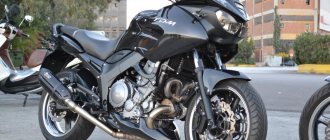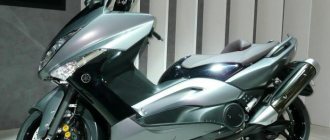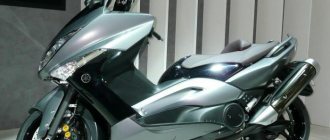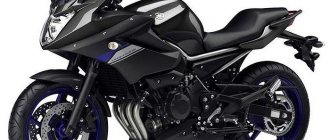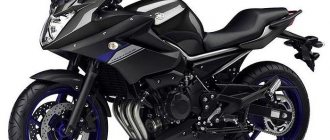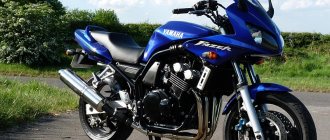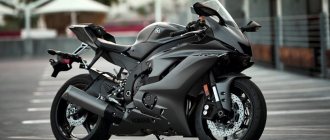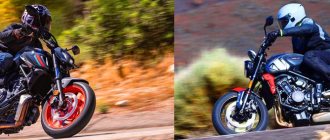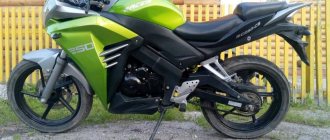Bike features
Here are the main features of the machine:
- good motor performance;
- comfortable seat;
- wonderful driving characteristics.
The latter is perhaps what 850 and 900 enthusiasts value most, along with versatility. Both motorcycles can perform well, not only on a smooth highway, but also on a rather rough road. Of course, the Yamaha TDM 900 is not an SUV, but it definitely shares some of the features of such motorcycles.
Yamaha MT -09 Tracer (2014 – present, RUB 765,000)
Yamaha MT-09 Tracer is a modern SUV. It combines a very attractive appearance, a complete lack of off-road “skills”, a torquey engine and a significant set of electronic assistants. When moving from the basic naked to the Tracer version, there were no changes to the chassis or brakes.
Engine
In-line 12-valve three with liquid cooling, displacement 847 cm3, peak power 115 hp. With. at 10,000 rpm and a six-speed gearbox it’s “lucky” and sounds like a modern motorcycle should. There is a slight hint of itchy vibrations. The engine is really not bad, but the picture is somewhat spoiled by the complexity of dosing the amount of mixture using an electronically controlled throttle valve. Customizable engine power output modes do not help. The motorcycle simply cannot ride calmly and without jerking during transitional conditions. An erratic jerking rhythm leads to accelerated wear of the drive chain.
Another well-known and repeatedly tested trick is the location of the drain plug in the crankcase pan below the level of the exhaust manifolds. Accordingly, you can forget about off-roading. Any careless crossing of the curb will lead to a puddle of oil on the asphalt and a trip to the tow truck for service. Occasionally, after 1500–2000 km, owners of new motorcycles out of the box experience warranty problems with the timing chain tensioner.
Transmission
The six-speed gearbox of the Yamaha MT-09 Tracer is completely devoid of “childhood diseases” and other artifacts. The gears switch smoothly and predictably. In the case of a particularly greyhound driving style, the drive chain turns into a fleeting consumable.
Frame and body kit
The frame of the entire Yamaha MT -09 family is hidden very deeply in the engine. To damage it, you need to hit the motorcycle with your forehead against a stationary object. All the little plastic is concentrated in the upper part of the motorcycle. You shouldn't expect any special strength from it. The purpose of the branched burdocks, designed to protect the controls and the driver’s hands, is extremely unclear. In fact, they significantly interfere with driving in traffic jams and seriously increase the cost of repairs in case of minor falls on the spot. Wind protection is already at a decent level as standard. Mainly thanks to the adjustable windshield.
Brakes
The brakes were almost completely transferred to the MT-09 Tracer from premium Yamaha sports models. However, despite the presence of ABS, to increase efficiency it would not hurt to install reinforced hoses on all circuits.
Pendants
An inverted telescope with a pipe diameter of 41 mm and a monoshock absorber with progressive rods require very precise adjustment to a specific driver (fortunately, everything for this is there). Standard settings from the factory are far from ideal, which can mislead owners. In terms of the nature of the suspension, Tracer is a 100% road bike. Soil is contraindicated for him!
Comfort
Comfort in the case of the Yamaha MT-09 Tracer is not only a comfortable fit and good wind protection. Pleasure and convenience, not least of all, depend on the anti-lock braking system, traction control, heated steering wheel grips, preparation for installing side cases and an engine operating mode selection system present in the basic equipment.
Modifications
There are no modifications except for differences in colors depending on the year of manufacture and the availability of a standard catalog of accessories.
Dimensions and weight
The bike has medium dimensions and reaches a length of 2180 mm, a width of 800 mm, and a height of 1290 mm. The wheelbase size here is 1485 mm, and the saddle height is 825 mm. The weight of the car without fuel is 190 kg, but with it it is already 221 kg. It's all about the large 20 liter gas tank. However, gasoline consumption here is very small, and on average it will take no more than 4.5 liters per hundred kilometers.
Tire selection
No matter how hard Yamaha tries to position the TDM and Tracer as "rogues", this will not stop them from being road motorcycles and needing road tires. Look in the sport-touring sections. Good options would be Dunlop Roadsmart - III, Metzeler Roadtec 01, Michelin Pilot Road 3 or 4, Pirelli Angel ST or GT, Conti Road Attack 2.
If the spirit of adventure doesn’t stop itching, then for the Tracer you can find tires that are a little toothier, like they put on the assembly line for touring enduros: Conti Trail Attack 2, Metzeler Tourance Next, Pirelli Scorpion Trail 2, or even a completely toothy off-road type like Conti Twinduro TKC 80 The last one is already extreme, but the remaining options will be extremely useful for travel routes towards the east and southeast of Moscow, where dirt on the roads and sand dunes creeping onto them are a normal occurrence.
With an 18” TDM front wheel everything is more complicated.
Nothing is produced by anyone in the world, but there is still one trick. You can install a 110/80–18 Pirelli MT 60 Corsa (shout out to the Ducati Scrambler, for which this wheel was created), which has good grip on asphalt and average grip off it, and in the standard size 160/60–17 the rear of the same is matched to it the model itself. And this is the only option, all other front wheels, even in size 110/80–18, will turn out to be rear wheels and with a speed index intended for SUVs with a volume of 150–225 cubic meters, for whom they were produced. For TDM, the speed index needs V (240) or W (270), in the most extreme case H (210), and then only with reservations. The motorcycle is fast and not the lightest. www.motorezina.ru So that the suit... does not fade > May 23, 2017 12:32 Mikhail Pimus
Chassis and brakes
Frame TDM 900 – Deltabox made of aluminum. Graceful and elegant, it will definitely please those who are not indifferent to the appearance of the iron satellite. The wheels are alloy, and the steering wheel is nothing particularly remarkable.
The rear suspension of the TDM 900 is a pendulum version with a monoshock absorber, and at the front it is a 43 mm telescopic fork. The rear brakes are a 245 mm disc with a single-piston caliper, and the front brakes are a pair of 298 mm discs with four-piston calipers.
Test drive Yamaha TDM 900
Opinion: Valera DRIVE.
Height: 186 cm.
Weight: 120 kg.
Driving experience: 25 years.
Drives: Honda XL650V Transalp and Suzuki DL1000 V-Strom.
“Out-of-class” - this motorcycle was born with such a label, it lived with it and modernized, being “one in three persons” - road worker/tourist/enduro. But, since it has long been known that hybridization is the search for the best combination of qualities through their compromise, it is clear that the acquisition of new advantages always leads to a “tail” of disadvantages. Not without them in this case either.
The 850 went through two serious modernizations (in 1996, the engine received a new crankshaft (with 2700 cranks, like V-twins, which gave the ordinary in-line engine a sound characteristic of V-twins) , and in 1999 - a new clutch, carburetors and gearbox).
With each modernization, the rating of the TDM 850 climbed up the mountain, and the model became increasingly popular, but still by the beginning of the 21st century it looked archaic: motorcycles with aluminum frames and a fuel injection system were already in the lead. In 2002, it was logical to introduce the TDM 900, which was freed from these anachronisms. When the V-Strom test with Varadero was being prepared, there was an idea that the TDM 900 would accompany them, but now it became clear that this would be unnecessary.
There are too many differences between them. Let's get acquainted with a motorcycle that is misunderstood by many, but at the same time adored by those who understand it.
I will probably have to be included in the first group, because in the short period of time that I communicated with “TyGyDym” (that’s what the Russians called him for the way the engine works), I was never able to fully understand him, he is so unusual and does not fit into the usual ideas about motorcycles. What's so unusual about it? The rather aggressive appearance has its own charm, and it is attractive, that is, it attracts attention and even fascinates, while the “face” of the TDM 900 looks absolutely individual and fresh even now, even regardless of the age of the motorcycle. But the proportions of the “body” already raise questions. Similar to a slightly enlarged mid-sized road bike, thanks to long-travel suspensions, it has considerable “height”, usually characteristic of enduro, and fairly developed side fairings, like those of medium-sized “tourists”. The dry-sump motor is reminiscent of its rally-raid origins. But exhaust pipes laid directly under the engine neutralize the advantages of “long legs”. All this eclecticism suggested that in the movement “TyGyDym” could be ambiguous.
An engine running at idle is definitely a bummer! The very first kilometer of city traffic showed how ambiguous the character of the engine is: in the range from “idle” speed to the 2200 rpm mark, crawling in a “traffic jam” is pure torture: the motorcycle moves jerkily, as if jumping at every slight turn of the handle. The situation improves dramatically only after the tachometer needle crosses the three thousandth mark. The engine is cheerful and quickly (as a parallel twin should do) spins up to the red zone. Although it cannot boast of sportbike acceleration dynamics, it is still better than most classics and road bikes. The only thing I didn’t like was when accelerating and driving, you had to rest your heels on the pads above the mufflers.
I liked the feedback of the throttle in the 3000 range - the “red zone”, the clear operation of the clutch and the quite satisfactory gearbox (which was much criticized for its noise and unclear operation on the previous model). On a warm engine, when searching for “neutral,” the foot often skips this position. I can’t help but note the performance of the front double-disc brake with calipers from the R1. The highest information content and efficiency of its operation allows you to save on optional ABS, and thanks to the weight distribution with a weight shift forward, with certain skills you can perform spectacular stoppies. True, the same weight distribution, enhanced by the slightly inclined position of the pilot, plays a “bad game” with the rear wheel: during sharp downshifts and with aggressive use of the brake pad, the TDM “sweeps its tail” (especially intensely on new tires). But I think that as soon as you seat a passenger and place “-eleven” kilograms of cargo on the trunk, this effect disappears. However, those who own supermoto equipment will consider this quality an advantage, not a disadvantage, and will be able to actively use it when taking sharp turns.
The suspension is good for two reasons: power reserve, energy intensity and the ability to completely adjust the rear shock absorber exactly to suit you. The latter is very important, since neglecting the adjustments negates all the advantages of TyGyDym on poor surfaces.
As for the tourist component, you can’t do without buying the highest possible glass - standard wind protection is simply not good at all and is only suitable for driving around the city. You will also have to purchase the rest of the “luggage and trunk” body kit, as well as engine protection (both lower and side). But, given the initially low price of the new model, this will not hit the wallet too much, especially since the versatility of using the TDM900 will increase sharply, and buying two more motorcycles will be incomparably more expensive than turning the existing one into a multi-purpose one.
Considering that journalists’ first impression of an untested motorcycle may be incomplete, and also that readers are usually interested in opinions after long-term use of the equipment, we decided in this test to deviate a little from the rules and give another opinion about the Yamaha TDM from owner of the exact same motorcycle.
Opinion: Vladislav Sofonov
Height: 180 cm.
Weight: 75 kg.
Driving experience: 7 years.
Rides: Kawasaki ER-5 Twister.
I love traveling, and of all the motorcycles, I like touring models the most. Apart from the Golda and the Pan-European, the Yamaha TDM is the next motorcycle I'm making plans for in the future. I understand that it is not entirely correct to put these three motorcycles in one line, but, in my understanding, they are all tourists, only the first two are completely ready, and the TDM is a kind of blank that should only be retrofitted to suit your needs. In addition, Yamaha costs much less, which means that a much larger number of motorcyclists can afford to buy it. Due to such partiality towards tourists and this model in particular, I could not refuse the opportunity to try out the motorcycle in action.
Already in the first minute of the test, I understood why people call the motorcycle “You-Gee-Smoke.” This is all due to the fact that the in-line engine works like a real “vehicle”. And its “You-You,.. You-You” at low speeds cannot be confused with anything else. However, it is at low speeds that these “You-You,.. You-You” cause some discomfort: when starting from a standstill, and even more so when riding at speeds up to 2 thousand (for example, in stretches) the motorcycle jerks strongly. So you shouldn’t lower the tachometer needle below this mark. However, this behavior at the “lower” range does not spoil the impression of the engine. His full potential is higher up the scale. As soon as you add some 500 revolutions, it already pleases with good traction, and the TDM900 confidently picks up speed. Up to the cutoff, the engine does not experience a noticeable pickup, but only a smooth linear increase in power. This is the advantage of twins, whether inline or V-twin. They have high output already in the mid-range of revolutions, and there is no need to rev the engine until a pig squeals in order for the motorcycle to accelerate briskly.
The gearbox worked smoothly during measured driving. When switching, a click was always heard and felt. But during active acceleration and high engine speeds, the gearshift lever for some reason “wedged” and to engage the higher gear, more effort was required than usual, and the gear was engaged only on the second or third attempt. Perhaps this was due to unused components of the box (the motorcycle was completely new) and over time this “glitch” will pass, but an unpleasant aftertaste still remained.
It is unclear for what reasons, but before the test it seemed to me that the Yamaha TDM would perform well on moderate off-road conditions. After the test, this thought completely disappeared from my head. Shod in purely road tires and not having much ground clearance, the Yamaha TDM has nothing to do outside of public roads.
During the test, it was drizzling lightly and on slightly wet asphalt the TDM very often left black streaks from the rear wheel - even lightly pressing the rear brake pedal led to it locking. It’s a pity that due to the weather we were not able to test the full power of the front brakes. Two 4-piston calipers from the R1 in combination with 298 mm discs have high potential. I liked that they were easy to handle - when you lightly pressed the handle, they worked very smoothly, but even for a sharp slowdown, only two fingers were enough strength. There were also moments when ABS was sorely lacking. It’s no wonder Yamaha offers a choice of two TDM models (with and without ABS). Believe me, having experienced the delights of this system at least once, it is subsequently difficult to refuse it. And on a bike like the TDM (with its tendency to suddenly lock up the rear wheel) it should be the default setting.
Since the stock TDM is sold without a touring body kit (saddlebags, bars, protection for handles, etc.), it is more reminiscent of an ordinary road bike with all that it implies: high traffic jam performance and maneuverability in the city, good resistance to gusts of wind and a high maximum speed ( when installing panniers, the recommended speed is reduced to 120 km/h). The seating position is quite comfortable. Only given the considerable dimensions of the motorcycle, its handlebars seem too narrow - every now and then you want to spread your arms wider. And in general, driving a stock TDM, as for me, is completely uninteresting and impractical. But equipped with three optional panniers, a high windshield, wind shields on the handlebars and other touring components, it will become completely different, full-fledged... And the “naked” TDM, as I already said, is just a blank for a “tourist”, and nothing more Togo.
Opinion: Richard Kazeev.
Height: 185 cm.
Weight: 126 kg.
Driving experience: 7 years.
Rides: Yamaha TDM 900.
I got the motor when it was two years old, but with only a little over eight thousand kilometers on it. The price was so attractive that I bought it without hesitation, especially since before that I had ridden the previous version with the “850” engine for two years and managed to “get attached” to this motorcycle. What attracted me so much to him? Its incredible versatility! I need a motorcycle, as they say, “for every day,” but I also love to travel, and not only abroad, but also in Ukraine, I travel a lot, but we don’t have roads - only directions. TDM is excellent in this regard - it is light in itself, quite narrow in body, has a high steering wheel that passes over the mirrors of cars and is easy to steer even at a speed of 5 km/h. These advantages are very valuable for a city with its dense traffic. Many, seeing the pipes passing directly under the engine, believe that TDM is not capable of overcoming the edges. This is wrong. When avoiding traffic jams, I storm standard low curbs without any problems, I just do it carefully.
The engine, although not very powerful by modern standards, is very high-torque and has a certain sporty “zing” - it spins easily and cheerfully, and, as they say, “all the way.” But he doesn’t like low revs at all: the motorcycle starts to move at least somehow only after the 2500 rpm mark.
Now the odometer shows a little more than 45 thousand kilometers, more than two-thirds of which I covered on various long-distance trips. The last one, in September, more than ten thousand kilometers long, went to Portugal. The handling of the “900” is good in gentle turns of low mountains, although it goes steadily on the autobahns, but the wind protection is weak: after 160 you need to hide behind... the highest tuning “windbreaker” (which I installed immediately instead of the standard visor). A comfortable cruising speed is 120-140 km/h, but if you drive for a very long time, the “fifth point” becomes stiff on a narrow seat, then you can get up and ride standing, holding the tank with your knees. The headlights are strong enough to move around in the dark, although I would put xenon in the “low” headlight.
Text: Valera DRIVE
Photo: michel
conclusions
Either the TDM is so unsuccessful, or the Honda is so adequate, but doubts disappeared in the first hundred meters riding the Honda. Having calculated the cost for an estimate, I realized that for the price of a new TMD, by giving away a “cat” in addition, you can get a new Honda CBF1000 and enjoy it endlessly (or at least another ten years). But whether I’m ready to “splurge” on a new moneymaker is a separate conversation ;).
ps
The last “painful” question is color! I really didn’t think that everything could be so bad, but besides red (baby, a relic of the past ;)), gray (well, no good!) and black and white there is nothing else! Horrible! The black is quite neutral, but the scratches on it are too visible (why isn’t there a matte black like on the CB1000R??). The V-Strom looked stylish (yes, unlike many journalists, I always liked the appearance of the V-Strom), but the CBF... and so it’s a sheep, and then there’s also a black one ;). It is difficult to say how “visible” it will be on the road. And white... until recently was considered “unsaleable”, but somehow a couple of years ago the opinion changed and it became quite “quotable”. And for such a “liner at heart” as the CBF1000, I would say it’s far from the worst option!
Share link:
- Click here to share content on Facebook. (Opens in a new window)
- Click to share on Twitter (Opens in new window)
- Click to share on Pinterest (Opens in new window)
- Click to share posts on Tumblr (Opens in new window)
- Click to share on LinkedIn (Opens in new window)
- Send this to a friend (Opens in new window)
Specifications
The technical characteristics of the Yamaha TDM 900 are far from the R1. But this vehicle does not claim to be the most powerful due to its versatility.
| Engine | 2 cylinders, 4 strokes, 5 valves |
| Volume, cm3 | 897 |
| Power, hp | 86 |
| Clutch | Disc with spring |
| Transmission | Six-speed |
| Drive unit | Chain |
| Frame | Aluminum |
| Brakes | Hydraulic disc |
| Front tire | 120/70 |
| Rear tire | 160/60 |
| Gas tank, l | 20 |
| Length, cm | 218 |
| Weight, kg | 226 |
